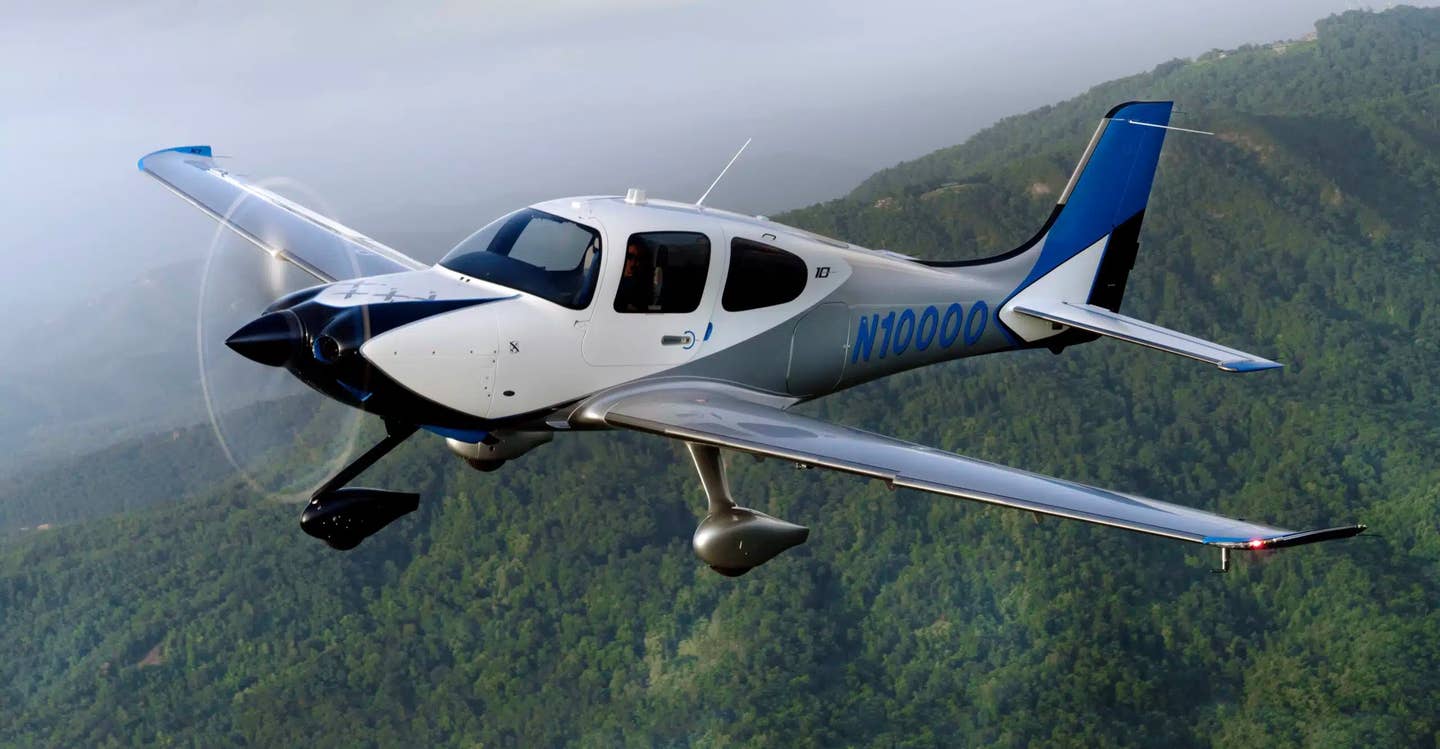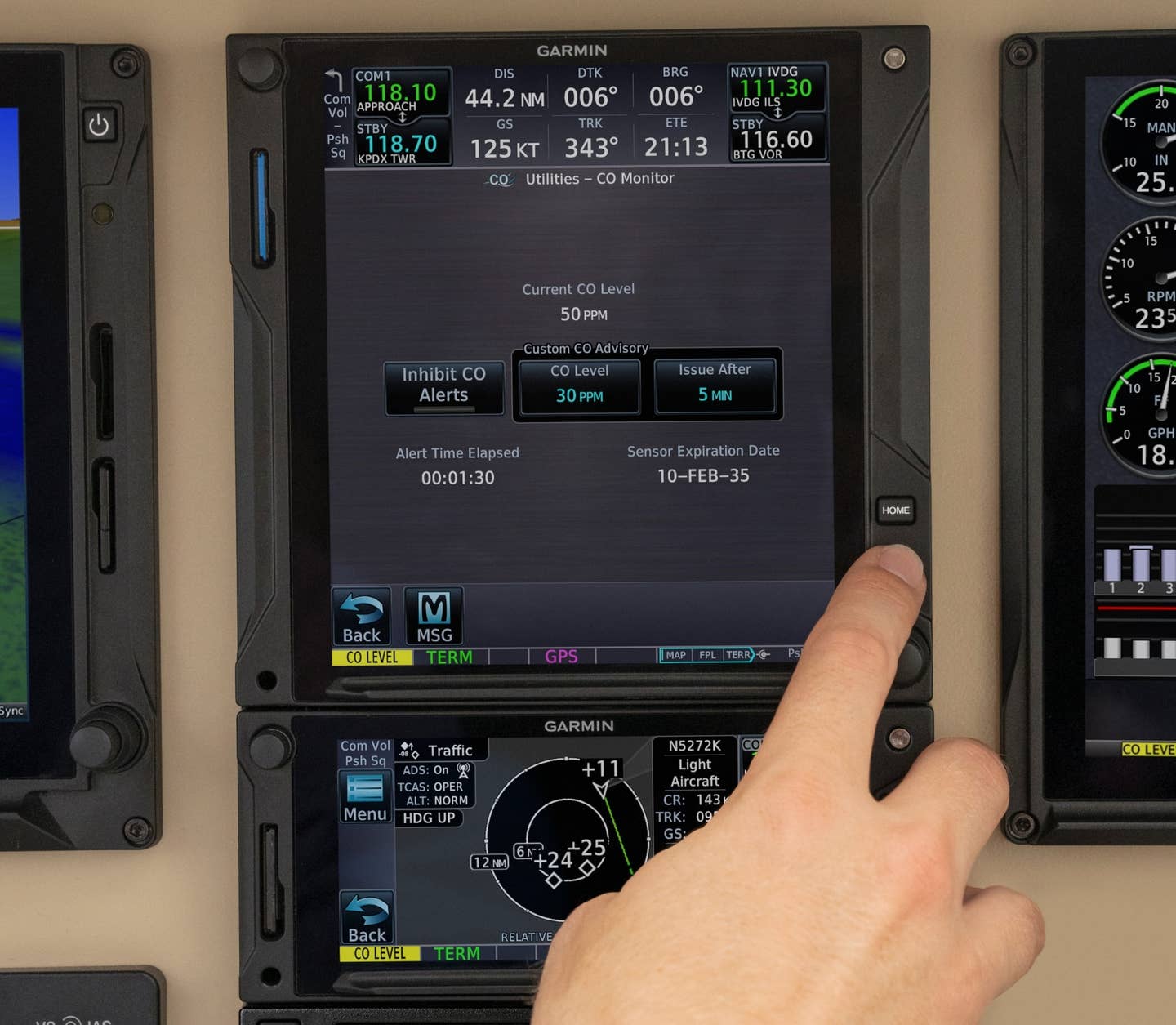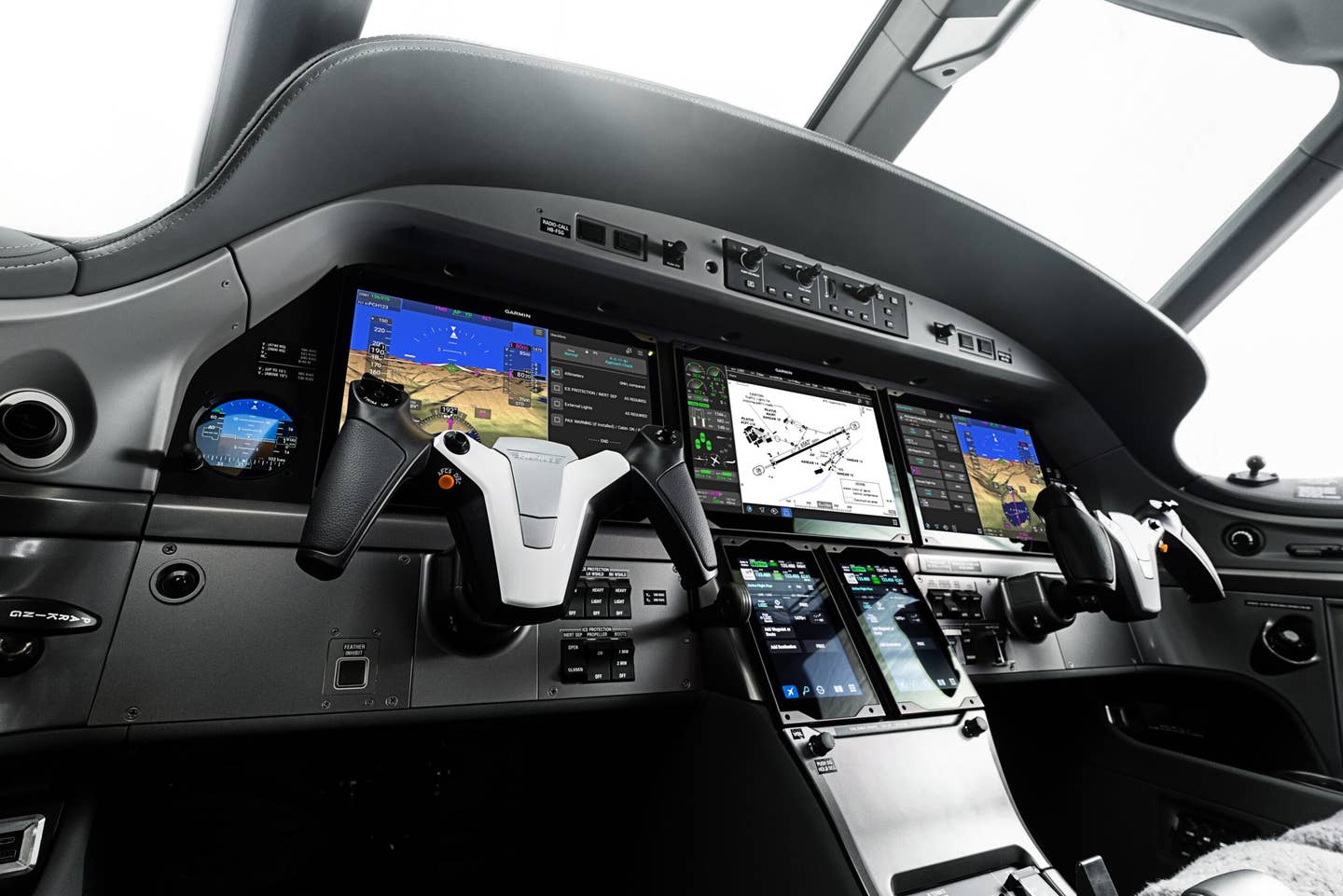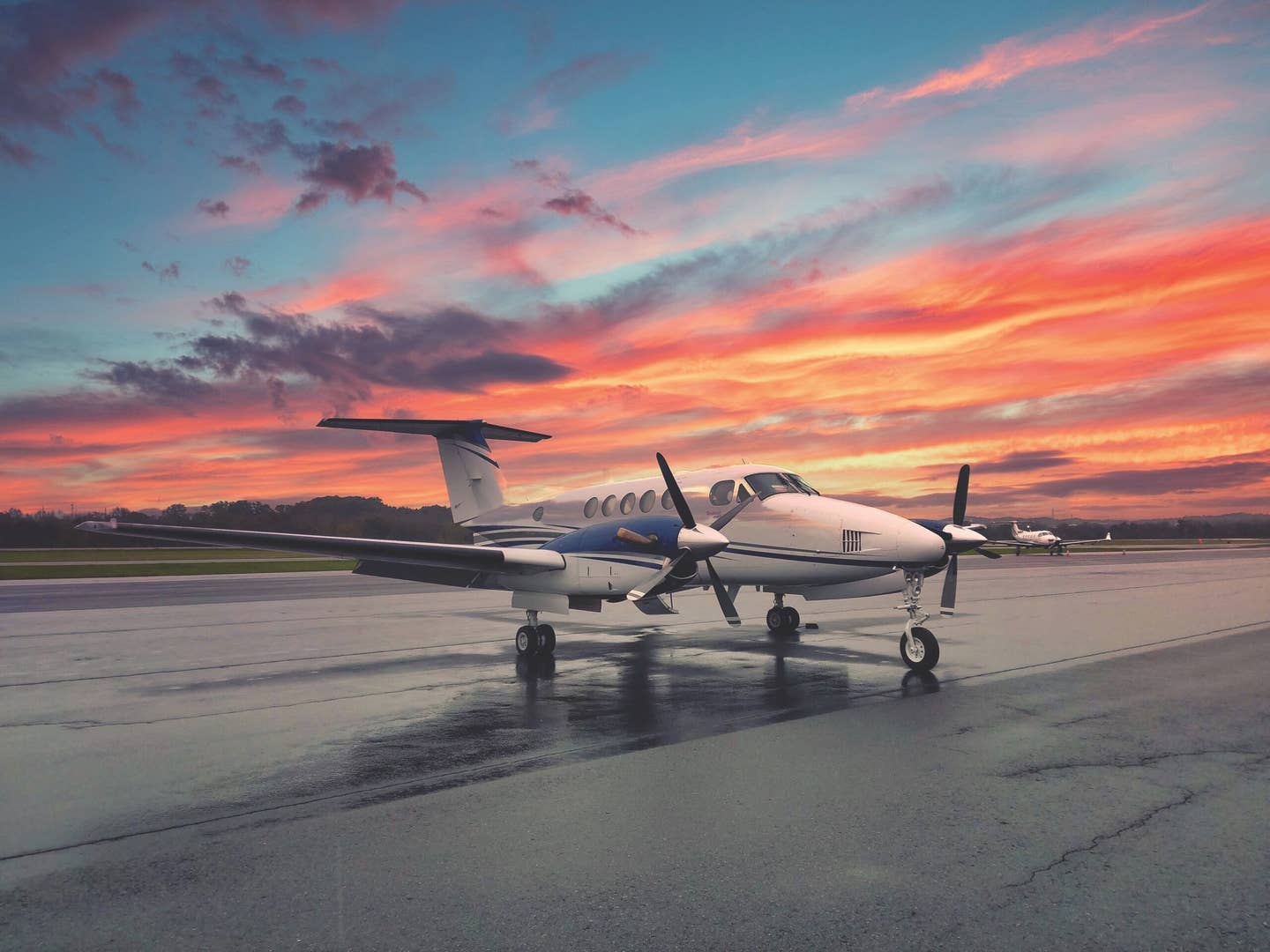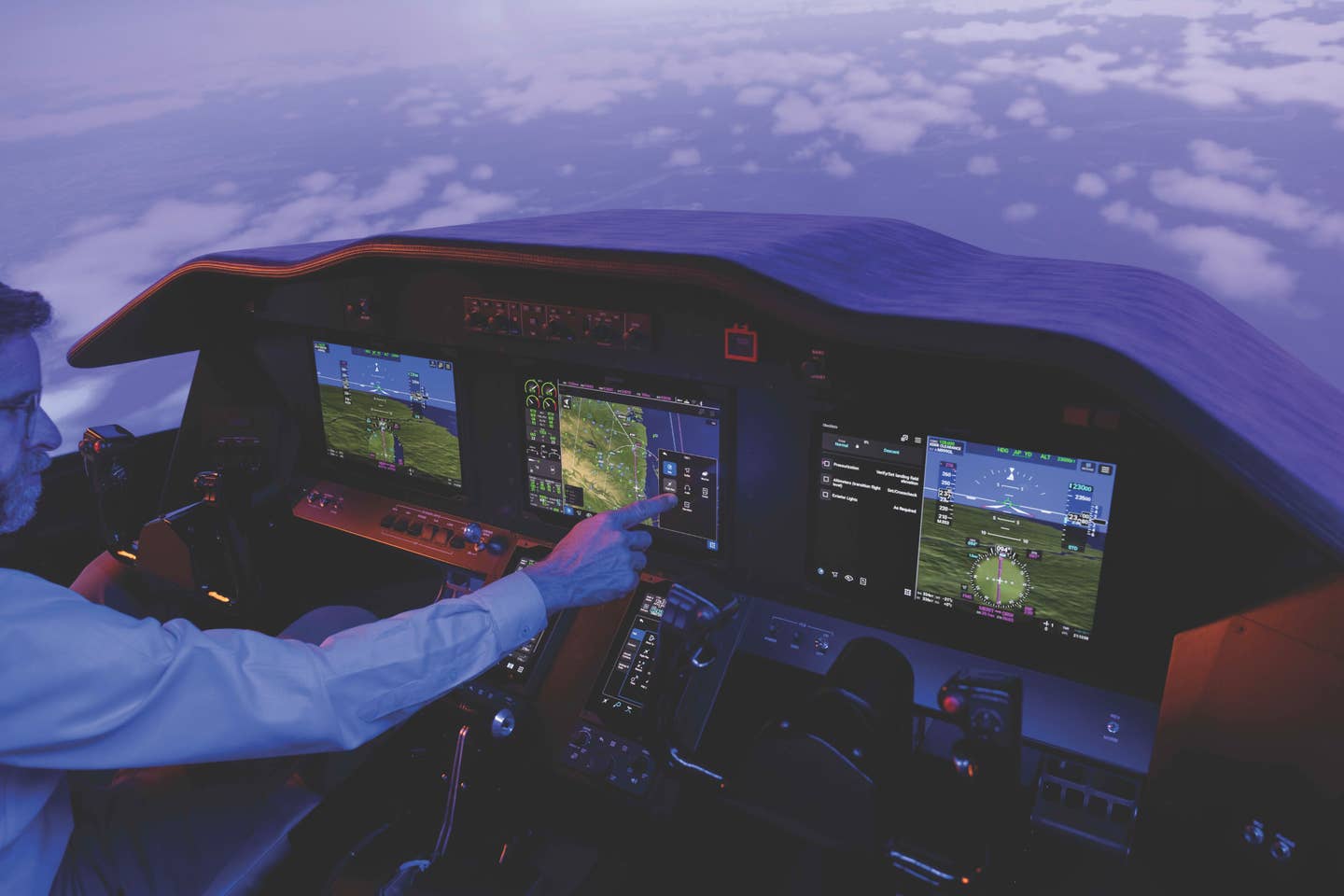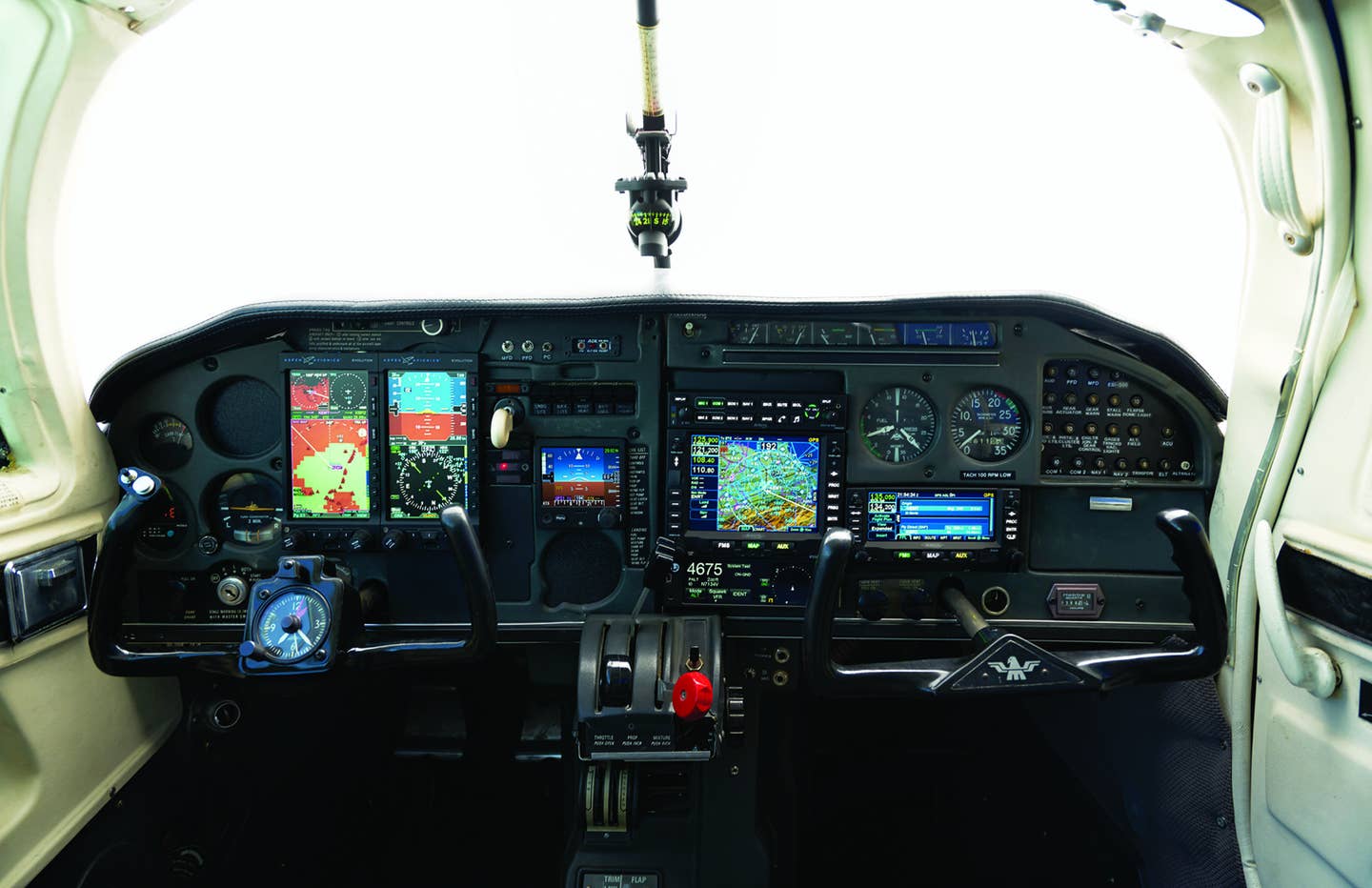
Manny’s new panel includes Aspen’s Evolution 2000 MFD/PFD combination, which talks to the L-3 Lynx NGT-9000 ADS-B transponder. Avidyne’s IFD540 and IFD440 FMS/GPS/navcoms and AMX240 audio panel round out the stack. Jeff Berlin
A few years back, my parents bought a beautiful tiled wood stove for their home. The first year, they bought a light truckload of wood. But Dad found buying wood to be a pricey way to feed the stove. Being retired with spare time on his hands and the desire for physical work, he decided to cut his own firewood. At first, he got permission from the local government to clear out wood from a lot close to my parents’ home where trees had been cut down to thin the forest. Then Mom and Dad set out to purchase a small wooded lot. In the end, they purchased an 11-acre property with three buildings and a lake. Why am I telling this story? Perhaps you can relate to a similar story of how the decision to buy one thing can lead to other, much bigger purchases. A new TV could lead to a new home audio system, which would require new furniture for the living room, and then perhaps even a new house. For me, the story has to do with avionics. When I bought my 1974 Mooney M20C, which I named Manny, I knew some upgrades would be required. The first and most serious need was a new transponder. Controllers would often tell me one of my digits was indicating something other than what was displayed on my analog Narco transponder. The issue was always resolved by twisting the errant knob around full circle. However, when it came time for the transponder check, the ancient unit came out flawed, and I spent nearly $1,000 fixing it. Since Narco has been out of business for years, it has become increasingly difficult to find someone willing to work on the equipment, and it is equally if not more difficult to find replacement parts. It was time for a change.
Manny would also have to comply with the upcoming ADS-B Out requirements in a few short years. I had learned about the L-3 Lynx ADS-B-compliant multifunction touch-screen transponder and figured it would be a great addition to Manny’s panel. And I thought it would be fun to add some shiny glass to the old-school avionics stack.
Having spent the past decade flying mostly on glass panels, it was a challenge to go back to round gauges when I bought the Mooney. The Narco transponder had matching MK-12D navcoms. In some ways, it was fun to twist VOR radials with an OBS, but I just didn’t feel as safe in the clouds as I had with WAAS GPS on board. So after I decided to add the Lynx transponder, of which the installation would require some major elective surgery to the panel and fuselage, I decided to explore what other parts of my panel I might want to upgrade.
Making decisions on what to put in the avionics panel is a much more complex challenge today than it was 20 years ago. When VORs and airways ruled our tracks in the skies, it was simply a matter of choosing a navcom unit or two, VOR indicator(s) or HSI, and a transponder capable of sending and receiving a signal. It was all pretty straightforward — find the units that had the best signal strength and reliability for your budget.
But these days, making panel choices is far more complex. There are multiple layers of decision-making as GPS, FMS, synthetic vision, weather, traffic and more have gradually been introduced into general aviation panels. Functionality, buttonology and screen quality are just a few things that today’s avionics consumers must spend time researching. Aside from that, avionics are constantly changing. Today’s latest and greatest technology could be completely outdated in 10 years.
A big part of me wanted to choose an all-Garmin stack since I am intimately familiar with a variety of the company’s fantastic products, including the GNS 430 and 530, GTN 650 and 750, G1000 and G3000. I also bought the GDL 39 a while back to get ADS-B In into my Garmin Pilot app, which has made flying with VORs again a little more palatable. Garmin’s products are top-notch, and its reputation for reliability and customer service is terrific as well. It would be an understatement to say I’m a fan.
I’d had little opportunity to experience Garmin’s light airplane competition other than playing with the equipment at exhibits at major aviation shows. I had already decided on the L-3 Lynx before Garmin came out with its all-in-one ADS-B solution, the GTX 345, and the Lynx communicates with the Aspen Evolution system, which displays the traffic and weather data from the transponder right in front of the pilot. The Aspen units display a ton of data in a compact package, a must for the tight real estate on the Mooney panel. Up for trying something new, I decided on a two-display Aspen Evolution 2000 combination.
Of course, the Aspen equipment would need to be fed by some kind of GPS source. I had almost decided to go with Garmin’s GTN 650 or possibly the GTN 750 when I learned that Avidyne’s IFD series had added some slick new features in the spring. The IFD540 and 440 navigators can be controlled with a miniature portable keyboard, which connects to the panel-mounted equipment via Bluetooth. I have really enjoyed flying with the keypads that connect with the G1000, so this new Avidyne hardware was attractive. Avidyne will also add synthetic vision with the next IFD software update, and the units might even eventually connect to the Internet because Avidyne partnered with Globalstar for satellite service. I also liked the fact that the IFDs have both hard keys and touch-screen capabilities, so I decided to go with Avidyne.
Initially, I was going to replace one of the Narco navcoms with an IFD440 or IFD540, leaving one of the old Narcos in the panel. But after reminding myself of the hefty transponder bill, I decided to remove all the obsolete Narco equipment. I could have replaced it with a different and simpler navcom. With more and more pilots switching to GPS, there are reasonable deals on more reliable, and better-supported used navcoms, such as the BendixKing KX 155. There are also some new basic navcom units on the market that would cost less than a second GPS. But in the end, I couldn’t resist getting the IFD540 for its instrument chart capability and the IFD440 as a second GPS/FMS for redundancy. I also matched the IFDs with Avidyne’s AMX240 audio panel. No more Narcos!
The more I delved into the avionics options, the more hypnotized I became by glass. Jeff Landon at High Desert Avionics in Lancaster, California, was already deep in the installation process when he suggested the addition of an electronic standby instrument. An all-glass M20C? Heck, why not? And while at the Sun ’n Fun International Fly-In in Lakeland, Florida, in the spring, I fell in love with the ESI-500 electronic standby instrument at the L-3 booth. It has a beautiful PFD display with options for synthetic vision, terrain, obstacles and navigation. And its small size — the body slips right into a standard 3-inch round hole — is perfect for the tight M20C panel. Yeah, I totally blew my budget, but, man, am I happy I did.
During the installation process, I visited Manny a couple of times in Lancaster. It was like visiting a friend in an intensive care unit. It was as if he was in open-heart surgery, with gaping holes and wires all over the place. With all the changes I made along the way, it was three months before I was able to crank up Manny’s purring O-360 once again.
The first time I saw the panel lighted up after the installation, I was in shock. It was absolutely stunning. While Landon managed to retain the old beat-up instrument panel, he somehow made it look as if all this new equipment was designed for the 40-plus-year-old panel.
There are way too many terrific features available in the electronic equipment to write about all of them here, but I’ll touch on some of my favorites. Avidyne’s MK 10 keyboard is as cool as I had hoped. It is small enough to fit into the pocket in front of my seat, and it makes entering and modifying flight plans quick and easy. I also love the fact that flight plans on the IFD units are color-coded: blue for airport, magenta for the next waypoint (like the active leg) and gray for the remaining fixes.
There are many ways to enter data into Avidyne’s IFD540 and 440. I’ve found myself using a combination of keys (on the unit itself and on the keyboard) and the touch screen. The pinch-zoom is fantastic, getting airport data and communications frequencies is quick, and the IFDs automatically load the missed approach procedure after the instrument procedure itself and activate the missed approach when you go past the missed approach point.
The Aspen MFD talks to the Avidyne units and displays the loaded flight plan on a moving map that can be decluttered based on preference. The PFD puts the vertical and horizontal guidance right onto the attitude portion of the primary flight display, showing all necessary cross-referencing parameters for instrument approaches in one tiny but easy-to-read format. Entering the minimum descent or decision altitude takes seconds, and that important number is also displayed right near the altitude tape, which has three levels of bugs to alert me when I’m getting close. The Aspen MFD and IFD540 are both capable of showing my ship position on the instrument chart or on the approach path on the moving map. Once on the ground, the MFD automatically goes to ground mode and displays the airport diagram, showing runways, taxiways and buildings.
I can also connect to a variety of iPad apps through the IFDs or the L-3 unit. I can stream a flight plan from the Avidyne to ForeFlight, and in later software updates, I will be able to stream a flight plan from the app to the unit, eliminating the need for entering fixes on the panel. Not that entering a flight plan is an arduous process. The system automatically includes victor airways, for example, so I can just enter the departure point and the first fix on the airway, select the airway and the exit point, and I’m done.
The L-3 Lynx makes it a breeze to enter transponder codes right on the touch screen. The ability to see weather and TFRs on the unit has come in handy, particularly with the fire season upon us in California. And I can check current metars simply by entering any airport code on the metar screen. The L-3 ESI-500, with its internal battery and functions that blow round-gauge backups out of the water, provides peace of mind in the event all the other equipment blacks out.
Another terrific feature is the ability to stream music to the AMX240 audio panel via Bluetooth. The sound quality is incredible. And when my son, Benjamin, starts to sing along into his headset mic, the isolation features justify the cost of the unit. The repeat button has also come in handy to clarify the details of an ATC call.
While I am absolutely thrilled with my new panel, I made some mistakes along the way. The biggest was bringing the airplane to High Desert Avionics before I had made my final decision on what to put in the panel, other than the Lynx transponder. That mistake and my indecision though the process ended up costing me dearly in installation cost because Landon and his team had to take apart the airplane more than once. Manny did not previously have any GPS antennas, so the airplane required major surgery for the equipment to function. The GPS antennas are not included with the avionics, which makes sense since many general aviation airplanes on the market already have GPS installed.
If you’re looking to upgrade your panel, get a quote from the avionics shop. The Avidyne IFD540 and IFD440 are direct replacements for the Garmin GNS 530 and GNS 430, which are commonly installed. Gary Reeves, who trained me to fly behind the Avidyne units, said it took about 30 minutes to slide his GNS 430 out and replace it with the IFD440. The installation cost in a situation like that would be minimal.
Learning the Panel The panel of my M20C went through a complete overhaul, replaced with equipment that I had not previously spent much, if any, time behind. Needless to say, I needed professional training to maximize the use of the new technology. I knew from experience that the basics, such as how to fly direct to some fix and how to tune in frequencies in the comm and nav boxes, are easy to figure out. But more technical inputs, such as loading a flight plan and activating approaches, are more complex. I was fortunate to be linked up with Gary Reeves of pilotsafety.org, who is a master CFI with more than 5,500 hours, to learn more about the Avidyne IFDs. After watching Reeves’ videos on the systems, I had a chance to fly with him in my airplane for a couple of hours to gain a deeper understanding. Reeves showed me how to configure the electronic checklists, load flight plans, use VORs and victor airways, twist radials and more. We also shot a few approaches into Long Beach and Camarillo. The experience was invaluable, and I felt much more confident with the IFD functionality after the flight.
I also got help figuring out the features of the Evolution 2000 PFD/MFD from Aspen’s Robert Blaha in Carlsbad, California. We spent time on a desktop trainer and in my airplane, going through the logic behind the buttons. The MFD has features such as angle of attack, weather, navigation, charts and more. It allows for a single view, or two or three split screens, so with all the different selections, it may take a while to finalize my ideal configuration. It’s a fun process. Now I just have to remind myself to look outside.

Sign-up for newsletters & special offers!
Get the latest FLYING stories & special offers delivered directly to your inbox

